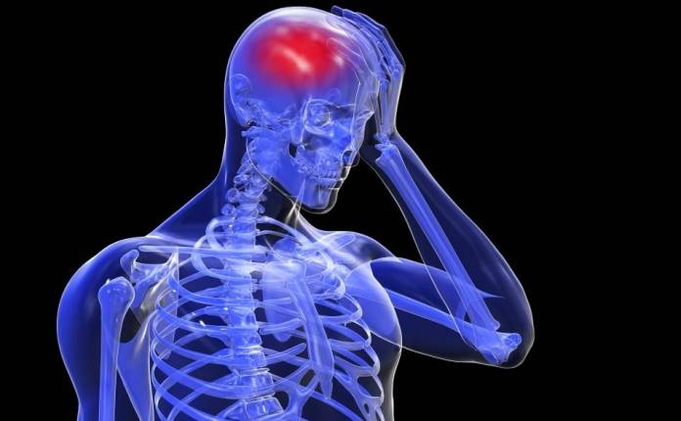Cervical osteochondrose is a spine disease, characterized by intervertebral disk disorders.Pathology is characteristic of the elderly, but the person of any age can come across it.Tangible discomfort causes one of the main signs of this disease - strong pain.The patient must know what cervically osteochondrondroose is dangerous and that problems will have to face.
Specifics of the disease
The cervical region is one of the most desirable parts of the body, and it meets regular loads.With the development of osteochondrosis, the vertebrae of shift, which leads to compressing numerous veins and nerves.The main complexity of pathology is that its characteristic dystrophical changes affect the roots of the spinal nerve and the intervertebral disk discs.Therefore, the brain remains without the necessary oxygen, blood is lost.

In the risk zone, there are primarily older people in which the disease develops against the background of metabolic disorders, and changes in the structure of vertebrae and interviolent disks are age.The reason for the development of such offenses can also be:
- Salt deposition;
- insufficient physical activity;
- irregular diet;
- injuries;
- Frequent hypothermia;
- Hormone problems;
- Excess weight;
- Chronic diseases.
Osteochondrosis also causes the long-term presence of the body in one position, which places employees in the office and drivers under the blow.
Symptoms of osteochondrose
In the initial phase of disease, the symptoms are almost invisible, anxiety can only cause mild neck pain.But as pathology is developing, the symptoms gradually increase.
The osteochondrosis of cervix can be identified by the following characters:
- Strong pain in the neck, hood, shoulders;
- Regular migraines;
- the weakness of the hand;
- The mobility of the door is limited;
- When they turn their heads, the vertebrates are brightened;
- Hearing problems;
- Characteristic rings appear in ears;
- Discomfort in the throat.
In the initial phases, the pain syndrome manifests only during movement, when it leans or turn the neck.Over time, it hurts even when your hands position changes.
Possible complications
If cervical osteochondrosis is not treated, degenerative processes on intervectors will lead to loss of their main functions and density reductions.Excessive mobility of the spine will gradually develop, muscles, joints and ligaments will suffer.Pressing the nerve endings and the spinal cord will only increase, which will lead to an increase in the symptoms and development of new pathological phenomena.

Frequent migraines
The most common consequences of osteochondrose of the cervical spine, you can calculate the headache.This is happening because it is located on this page that is the vertebrate, which is responsible for shipping oxygen and blood into the brain.
As the strength on the disk changes, depreciation functions were violated.Deformed vertebrate press on artery, interfere with blood circulation and "delivery" of the required oxygen.Understanding muscles develop.
After pain, simultaneous symptoms often follow:
- nausea;
- vomits;
- a sharp increase in pressure;
- tingling in the blades;
- Weakness throughout the body.
With heavy attacks, it is desirable to relax as much as possible, it is better in the horizontal position.An unpleasant syndrome can remove painkillers or colder compresses, while massage is useless.
Vida problems
Complications of cervical osteochondrosis often affect visual bodies: In this part of the spine, there is a sleepy and vertebrae of the artery, which are responsible for blood flow to a visual central structure.The nervous root and blood vessel compression lead to hypoxia and cause vision reduction.
Together with vertebrate artery syndrome, symptoms such as:
- fog;
- blackout in the eyes;
- the appearance of "flies" or colored stains;
- Bifurcation;
- Excessive stress of optical nerve;
- dizziness;
- Nausea.

During the examination, the specialist may notice the narrowing of the arterial vessels of the retina eye, less often there is a swelling of optical nerves.Also, a glaucoma can appear against the background of the disease, accompanied by increased intraocular pressure and pain.
Hearing problems
Due to the compression of spine and ervous, hearing loss is possible by 20-30%.Neglected cervical osteohondrond can lead to even complete deafness.To avoid this, you must contact your doctor on the first symptoms of the disease.
The slight hearing reduction is reversible: In addition to drugs, the medicine prescribed by the doctor, the patient needs special exercises or massage shells ear.Watching television or listening to music is better in a small volume to dry the organs.
Hypotence or hypertension
Reduced or increased blood pressure are quite common consequences of cervical osteochondrosis.The biggest danger is hypertension, which are characteristic:
- Gathering of the pulse;
- Increased temperature sensitivity;
- Sleep disorders;
- nasal bleeding;
- dyspnea;
- heart pain;
- Sweating.
The higher blood pressure, the greater load falls on the heart, which leads to its fast spending.As a result, heart failure develops.In hypertension, atherosclerosis develops faster, which is dangerously with stroke.
Hypotenia is not a direct threat to life, but greatly affects quality.The body is experiencing starving oxygen, which affects the patient's general well-being.Hypotonia is characterized by a violation of the venous and arterial blood supply, and this implies disruptions in the sensitivity of the limbs.Among the possible complications are myocardial infarction.

Welses -Vascular Dystonia
Welses - Visascular Distonia is a general mark of syndrome, which can affect several bodies and organs.Most pathology, cardiovascular system and peripheral nerves suffer from pathology.The patient has constant anxiety and sharp emotional differences.Possible and common panic attacks, and the heart rhythm becomes more common.
Dystonia symptoms can be lubricated or dressed as other diseases.The consequences of the osteochondrose of the cervical region in this case are also not the most pleasant.Thus, the gastrointestinal tract often suffers: nausea and vomiting, diarrhea, prison and severe abdominal pain are possible.A gallbladder or liver disorders are possible.Patients often complain about tachycardia, pressure problems and heartache.
Intervertebral hernias
With intervertebral kili, the disc fragments are "protruded" in the spinal channel or fall out.The initial phase of this pathology is called the protrusion.The integrity of the interverter disc does not disturb it, but there is a light bulge of bones in the spinal channel.At this stage, pressure on the root of the spinal cord, so the main symptom is weak pain that occurs during the movement.In later stages, pain syndrome is improving.
The mobility of the vertebral is gradually decreasing.Muscle tension improves, even if the patient seems in a relaxed state.You can also notice periodic weakness in the upper parts of your hands or in the joints.The stiffness of the hands appears, and the running of the tingling often appear near the thumb.
This is what is dangerous osteochondrosis of cervix with a kikot: has a serious load on the artery, which passes by the vertebrae and is needed for the correct blood supply to the brain.If excessive patient pressure appears, an ischemic stroke can be expected.
The great hernia is dangerous for inflammation of the surrounding ligaments - this is full of cervical radiculitis.Only timely treatment can prevent complications.The patient should listen to his body carefully and in the first symptoms to consult with a doctor.Doubts should cause:
- sharp attacks nausea without visible reasons;
- By eclipse in the eyes when moving;
- noise in ears when turning their heads;
- Withdrawing the sensation in the neck with a long stay in a standing position.
The most serious complications are the risk of irreversible paralysis of one or both hands.Attrophy of cerebral nerves leads to this, located in the region of Grlić uterica.If a hernia starts pressure on blood vessels, she will gradually die, which will lead to innovation of the organs.
Vestibular barrel syndrome
The vestibular barrel syndrome is a state in which the patient experiences a strong dizziness that accompanies the loss of orientation.
Attacks occur with a sharp rise, quick turning or throwing head back.Characteristic of the state:
- noise in ears;
- nausea;
- visual impairment;
- The feeling of getting everything revolved and hovered before his eyes.
The main reason for pathology is the lack of blood supply, which implied the dysfunction of the vestibular apparatus.The syndrome will occur more and more often as osteochondrosis is developed.
Syndrome Slave Minute
Started osteochondrose is dangerous with neuro-vascular throat disorders and larynx.Syndrome is characterized by:
- hoarseness;
- Difficulties when swallowed;
- a permanent sensation to whom in the throat;
- dryness and pain;
- Complete voice loss.
Simer appears suddenly and follows dizziness.
Bar Lieu Syndrome
The second name of pathology is the vertebrate artery syndrome.The reason for its development is stenosis (narrowing) canal vertebrae, in which the cramps of the vertebrae and the compression of blood vessels and nerves are compressed.
Symptoms include:
- hypertension;
- nausea;
- tachycardia;
- Carrying in the eyes;
- noise in ears;
- Loss of motion coordination;
- pulsing pain in temples or in the occipital area.
With a sharp motion or turning the door, the patient may lose consciousness.

Hypotol syndrome
At the same time, the hypothalamus suffers from syndrome - part of the brain that is responsible for metabolism, pressure, sleep, body temperature and the person's emotional reactions.Functional disorders can be manifested by improving or weakening the activity of the brain.In the first case, the patient becomes irritable, in the second - inhibited.
Symptoms often remind of the neurastria, which is manifested through:
- Sleep disorders;
- indignation;
- irritability;
- High fatigue;
- Mood instability.
The person loses the opportunity to concentrate, there are problems with memory.There are unreasonable outbreaks of anger, appetite disappears, Libido decreases.
It is better to prevent any illness than to treat, predict the behavior of osteochondrose is quite difficult.If there are risk factors, you must regularly perform a set of simple physical exercises that will increase vertebral mobility and eliminate congestion in the collar area.
The frequent appearance of any of the symptoms described is an obvious signal of the body about the problems that occur in it.At the same time, self-identification is useless, and without consulting the expert will not succeed.

















































